Optimism and Pessimism
Why are so many people pessimistic about the future? And what can this tell us about tackling the world’s largest problems?
At Our World in Data we focus on the world’s biggest problems: to understand what they are and how we tackle them.
One of the most important points that emerges from the historical data that we cover is that the world is much better than it was in the past. Child mortality is a fraction of what it was; fewer people die from disease, conflict and famine; we live longer and healthier lives; and most children get the opportunity to go to school and receive an education.
Yet many of us are unaware of this progress, and – especially this in richer countries – often have a negative view on how the world has changed. Why are we so pessimistic about our collective past, and our future?
Understanding optimism and pessimism is important: to tackle the big problems that the world faces, we need founded optimism that things can improve. On this page we look at data and research on optimism and pessimism, and how this is influenced by context and social circumstances.
Individual optimism and social pessimism
It is a peculiar empirical phenomenon that while people tend to be optimistic about their own future, they can at the same time be deeply pessimistic about the future of their nation or the world. Tali Sharot, associate professor of psychology at UCL, has popularised the idea of an innate optimism bias built into the human brain.1
That is, we tend to be optimistic rather than realistic when considering our individual future. If you were to ask newlywed couples to estimate the probability they will divorce in the future, they would likely reject the possibility outright. Yet today roughly 40% of marriages in the UK end in divorce. Another example is asking smokers to estimate their chances of getting cancer and again, most would underestimate their risk. This optimism persists even when people are presented with the relevant statistics.
Consider the following graphs from the European Union's Eurobarometer surveys; they report people's expectations about their own personal job situation and of the economic situation in their home country. From the end of 1995 to the middle of 2015, around 60% of people predict that their job situation will remain the same, while 20% expect their situation to improve. Compare that with the response of the same group of individuals considering the future of the economic situation in their home country. Although far less stable, the results show that most people expect the economic situation in their home country to get worse or stay the same. The expectation that things are going to worsen nationally is correlated with recessions, yet there is remarkable stability in the results for individual expectations. Does the response to the question about national economic well being better correspond to an individual's true job prospects?
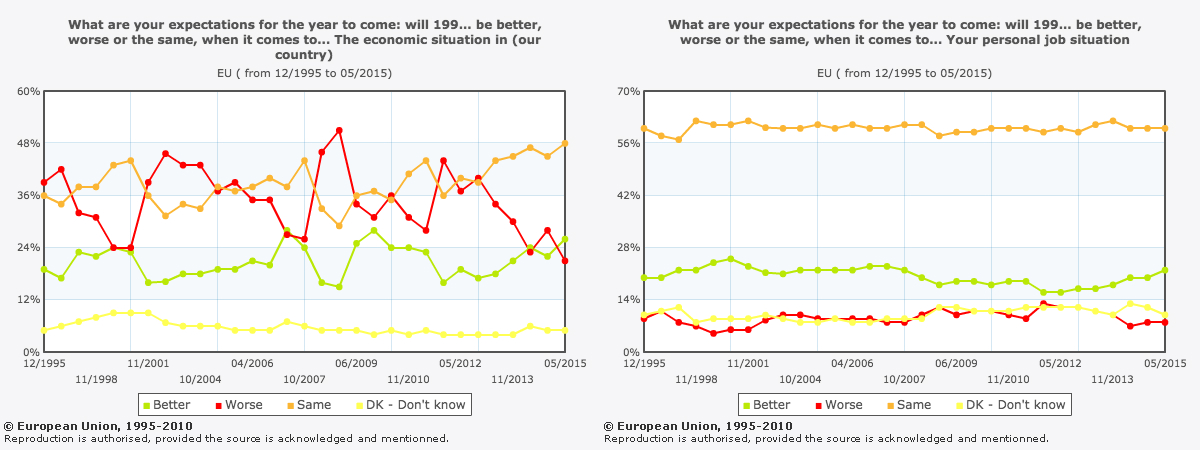
We are local optimists and national pessimists – in politics
This pattern is also observed on a larger scale. This chart shows how individuals in the UK respond to the question: "Thinking about ..., how much of a problem do you think each of the following are in your local area and in the whole of the UK?" Individuals tend to believe problems are more pronounced nationally than in their local area.
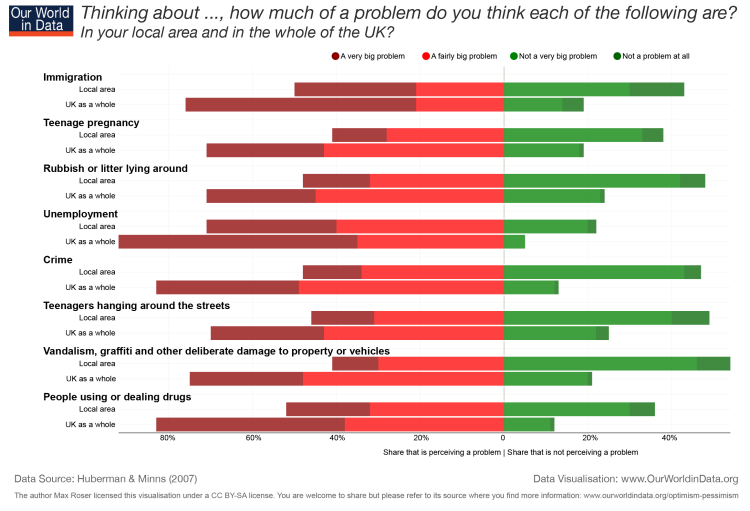
We are local optimists and national pessimists – in environmental aspects
This chart shows how many individuals rate the environment in their local area as fairly or very bad, compared with the environment nationally and globally. Again, we observe a similar pattern for most countries. No matter where you ask people are much more negative about places that are far away – places which they know less from their own experience and more through the media.
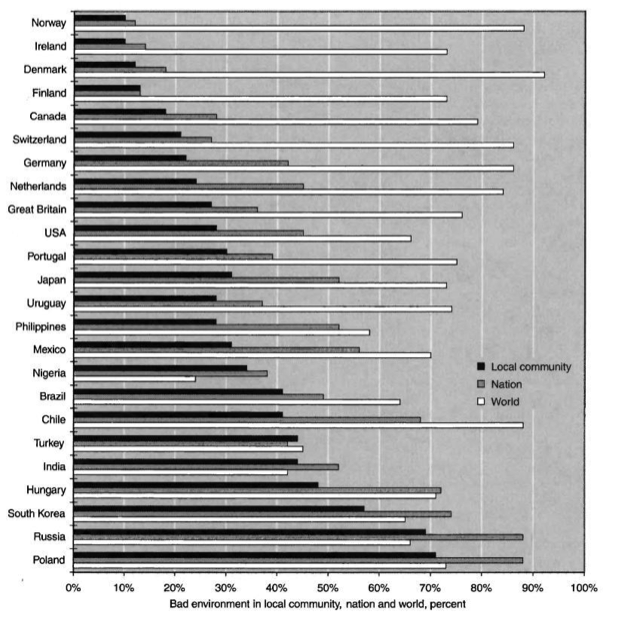
Why are we social pessimists?
How can we reconcile this individual optimism with social pessimism? Paul Dolan, professor of behavioural science at LSE, believes people respond pessimistically to questions about national or international performance for three reasons:
- Individuals rarely think about grand issues such as the state of the nation or world, and so respond with an 'on-the-spot' answer that may not be well considered or even a true reflection of their beliefs.
- The framing can influence the individual's response. Moreover, the question itself may bias responses; 'who would bother to ask if everything were okay?'
- Responses to questions such as these (and more general questions about happiness or life satisfaction) are heavily influenced by ephemeral recent events. In psychology this is referred to as the 'availability bias'.
This explanation suggests there is a problem of information. If we do not pay attention to human development, then our judgement may suffer from a bias related to transient events or framing. The Gapminder Ignorance Project – which studied how wrong or right people are informed about global development – suggests the reason for all this ignorance is:
"Statistical facts don’t come to people naturally. Quite the opposite. Most people understand the world by generalizing personal experiences which are very biased. In the media the “news-worthy” events exaggerate the unusual and put the focus on swift changes. Slow and steady changes in major trends don’t get much attention. Unintentionally, people end-up carrying around a sack of outdated facts that you got in school (including knowledge that often was outdated when acquired in school)."
Another explanation put forward by Martin Seligman, professor of psychology at the University of Pennsylvania, suggests a link between control and optimism. If we feel more in control of our lives, we tend to be happier, healthier and more optimistic about the future. This could also help to explain the gap between individual and societal optimism: since we are in direct control of our own lives but not the destiny of the nation we feel more optimistic about ourselves.
Information matters: We are not only pessimistic about the future, we are also unaware of past improvements
At Our World in Data we aim to bring together the empirical data and research to show how living conditions around the world are changing. Is that necessary?
The opinion research organization Ipsos MORI conducted a detailed survey of 26,489 people across 28 countries that gives us an answer.5
Most people think global poverty is rising when in fact the opposite is happening
The first chart shows how the surveyed people answered the following question: “In the last 20 years, the proportion of the world population living in extreme poverty has decreased, increased, or remained the same?”
The majority of people – 52% – believe that the share of people in extreme poverty is rising. The opposite is true. In fact, the share of people living in extreme poverty across the world has been declining for two centuries and in the last 20 years this positive development has been faster than ever before (see our work on Poverty). For the recent era it doesn't even matter what poverty line you choose, the share of people below any poverty line has fallen (see here).
There are some people who answered the question correctly: every fifth person knows that poverty is falling. But it’s interesting that the share of correct answers differs substantially across countries. The countries I marked with a star are those that were a low-income or lower-middle-income countries a generation ago (in 1990). In these poorer countries more people understand how global poverty has changed. People in richer countries on the other hand – in which the majority of the population escaped extreme poverty some generations ago – have a very wrong perception about what is happening to global poverty.
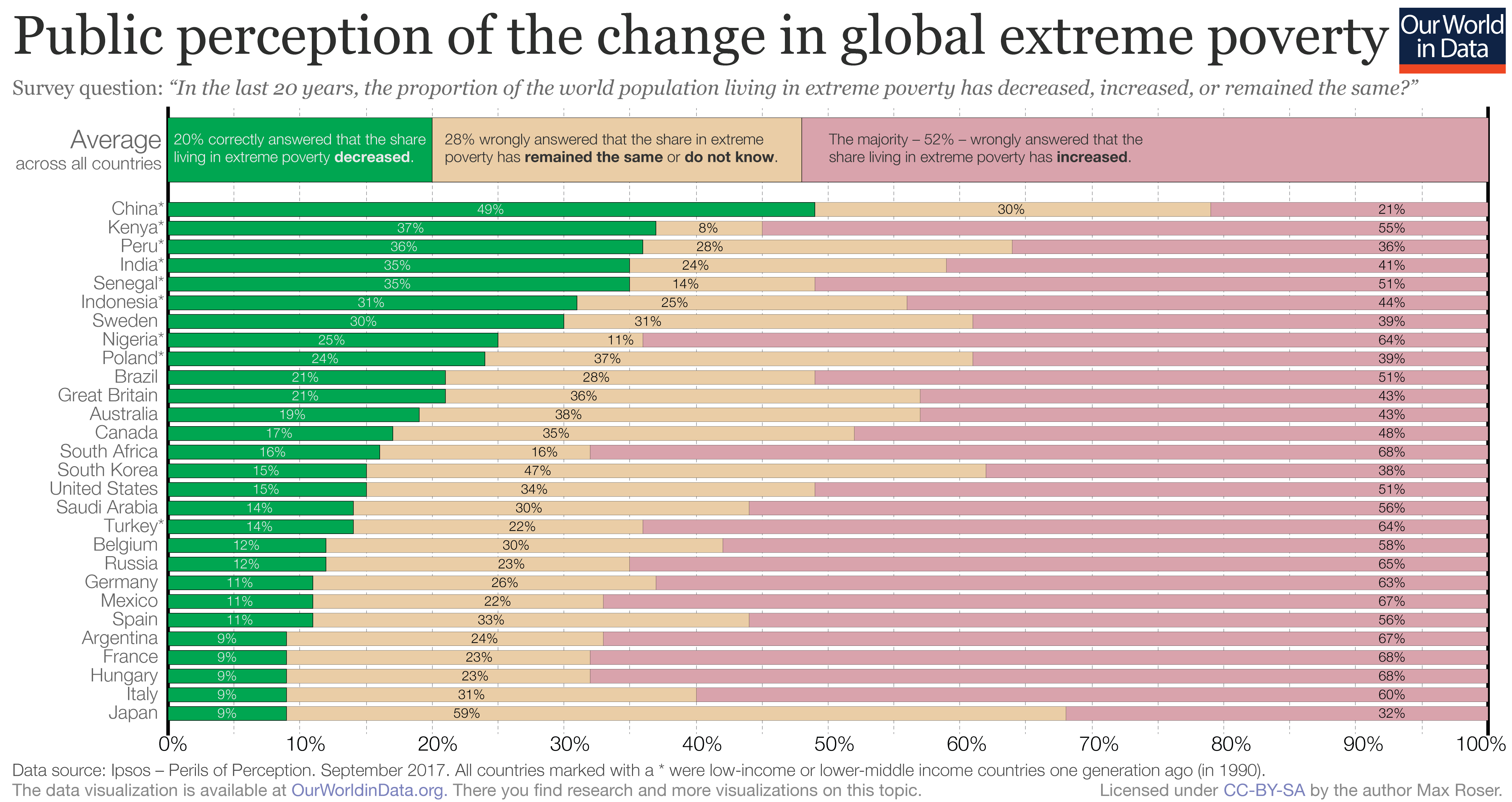
Most people don’t know that child mortality is declining in poor countries
We are not just wrong about global poverty. In the same survey people were asked: “In the last 20 years, has the child mortality rate in developing regions increased, decreased or stayed about the same?”
Here again the data is very clear. The child mortality rate in both the less- and least-developed countries has halved in the last 20 years.6
The survey once more shows that most people are not aware of this. On average only 39% know that the mortality of children is falling. And what greater achievement has humanity ever achieved than making it more and more likely that children survive the first, vulnerable years of their lives and sparing parents the sadness of losing their babies? This has to be one of humanity’s greatest achievements.
And just as with knowledge about extreme poverty, the share of uninformed people is much higher in the rich countries of the world. So is our work at Our World in Data needed? This survey shows that few Senegalese or Kenyans will learn something new; but if you have some friends in the US or Japan you will probably help them if you share our work.
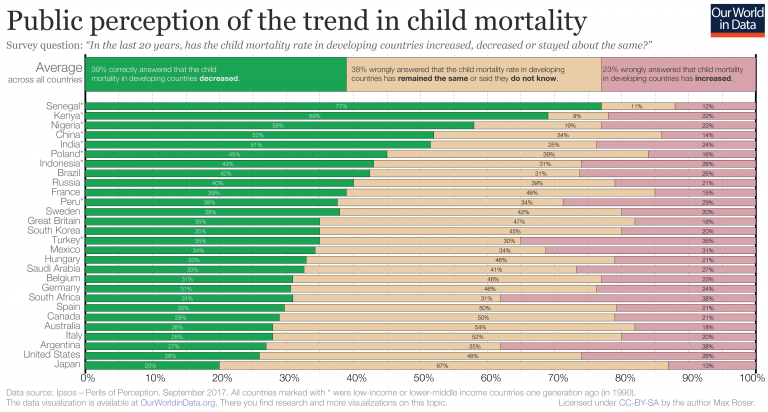
How does this matter?
1. Misperceptions about specific trends reinforces general discontent about how the world is changing
The widespread ignorance about these truly important changes in the world feeds into a general discontent about how the world is changing. When YouGov asked in a separate survey the more general question: “All things considered, do you think the world is getting better or worse?” there were very few who gave a positive answer. In France and Australia only 3%(!) think the world is getting better.
And again we see that in poorer countries the share of people who answer positively is higher.7
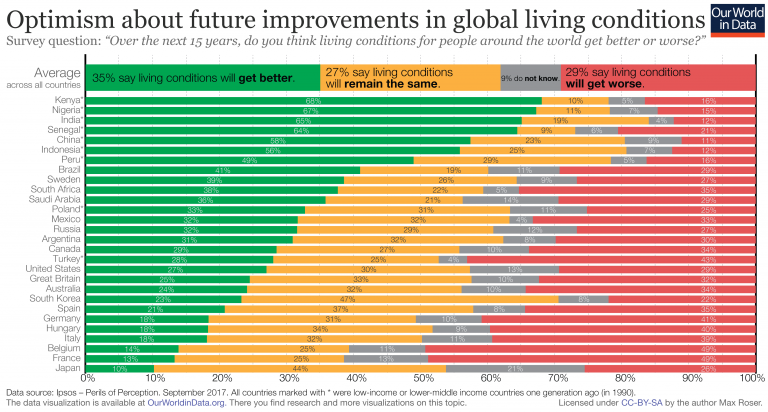
2. Misperceptions reveal a failure of our media and our education systems
What should we make of the fact that many perceive the world to be stagnating or even declining in global health or poverty while we are in fact achieving the most rapid improvements in our history in these very same aspects?
First, this is simply sad. It means that we think worse of the world than we should. We think more poorly than we should about the time we are living in, and we think more poorly than we should about what people around the world are achieving right now.
Second it makes clear that we are doing a terrible job at understanding and communicating what is happening in the world. Particularly in rich countries the education systems and media are failing to convey an accurate perspective on how the world is changing – arguably one of the main expectations we should have of them.8
3. We are not just negative about the past, we are also pessimistic about the future
Our perception of how the world is changing matters for what we believe is possible in the future.
If we ask people about what is possible for the world, then most of us answer ‘not much’. This chart documents the survey answers to the question “over the next 15 years, do you think living conditions for people around the world get better or worse?”. More than half of the people expect stagnation or that things will be getting worse. Fortunately, the places in which people currently have the worst living conditions are more optimistic about what is possible in the coming years.
On the whole, the findings from the surveys are clear: we do not only believe that the world is stagnating or declining, we also expect that this perceived stagnation or decline will continue into the future.
This pessimism about what is possible for the world matters politically. Those who don’t expect that things get better in the first place will be less likely to demand actions that can bring positive developments about. The few optimists on the other hand will want to see the necessary changes for the improvements they are expecting.
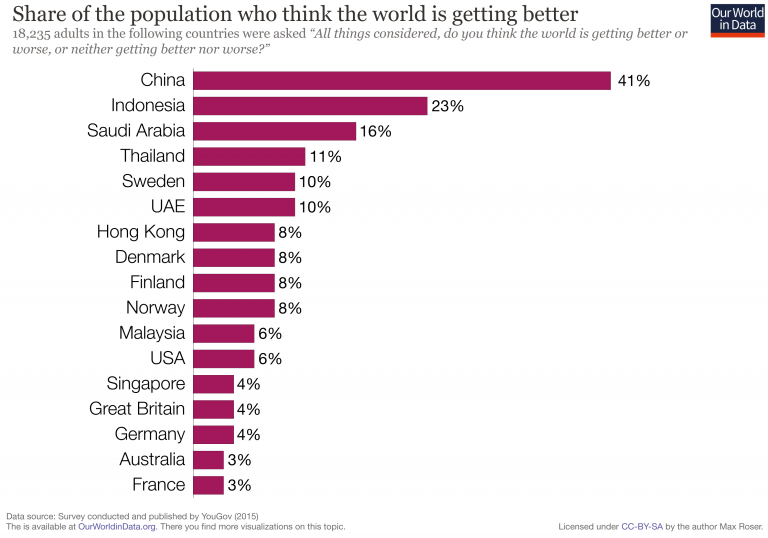
Knowledge about what we have achieved leaves no place for cynicism
Finally the survey suggests that there is a connection between our perception of the past and our hope for the future. This chart shows that the degree of optimism about the future differs hugely by the level of people’s knowledge about global development.
Those that were most pessimistic about the future tended to have the least basic knowledge on how the world has changed. Of those who could not give a single correct answer to the survey questions, only 17% expect the world to be better off in the future. At the other end of the spectrum, those who had very good knowledge about how the world has changed were the most optimistic about the changes that we can achieve in the next 15 years.
This is a correlation and as we know, correlation does not imply causation. To understand whether there is a causal link we would need to know whether getting a more accurate picture of how the world is changing makes one change one’s belief about what will happen in the future. Unfortunately I am not aware of a study that looked into this question.9
Of course no one can know how the future turns out and there is nothing that would make the progress we have seen in recent decades continue inevitably and not every global development pessimist is ill-informed. But what we do know from these surveys is that these two views go together: Those who are pessimistic are much more likely to have little understanding about what is happening in the world.
Obviously the question then is, why is it that better informed people are more optimistic about the future?
As we have seen, being wrong about global development mostly means being too negative about how the world is changing. Being wrong in these questions means having a cynical worldview. Cynicism suggests that nothing can be done to improve our situation and every effort to do so is bound to fail. Our history, the cynics say, is a history of failures and what we can expect for the future is more of the same.
In contrast to this, answering the questions correctly means that you understand that things can change. An accurate understanding of how global health and poverty are improving leaves no space for cynicism. Those who are optimistic about the future can base their view on the knowledge that it is possible to change the world for the better, because they know that we did.
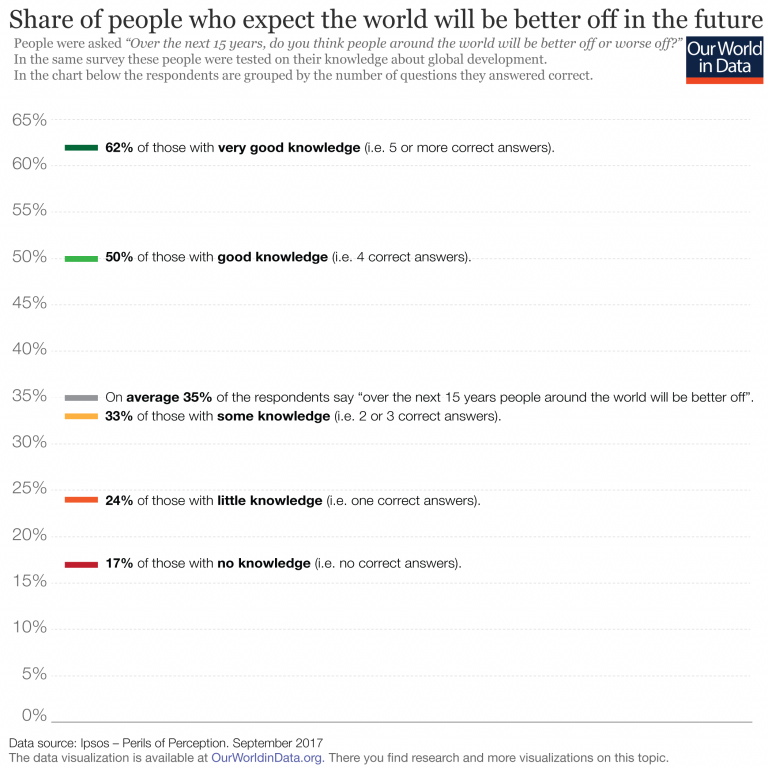
This article was restructured and shortened in March 2023.
Cite this work
Our articles and data visualizations rely on work from many different people and organizations. When citing this article, please also cite the underlying data sources. This article can be cited as:
Max Roser and Hannah Ritchie (2018) - "Optimism and Pessimism". Published online at OurWorldInData.org. Retrieved from: 'https://staging-owid.netlify.app/optimism-and-pessimism' [Online Resource]BibTeX citation
@article{owid-optimism-and-pessimism,
author = {Max Roser and Hannah Ritchie},
title = {Optimism and Pessimism},
journal = {Our World in Data},
year = {2018},
note = {https://staging-owid.netlify.app/optimism-and-pessimism}
}Reuse this work freely
All visualizations, data, and code produced by Our World in Data are completely open access under the Creative Commons BY license. You have the permission to use, distribute, and reproduce these in any medium, provided the source and authors are credited.
The data produced by third parties and made available by Our World in Data is subject to the license terms from the original third-party authors. We will always indicate the original source of the data in our documentation, so you should always check the license of any such third-party data before use and redistribution.
All of our charts can be embedded in any site.

